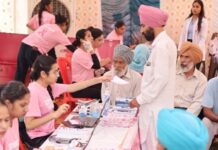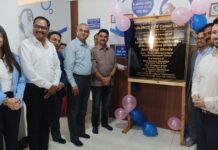- National Bone & Joint Day is observed on August 4 to raise awareness about disorders of bones and joints, their prevention and treatment
New Delhi, August 07, 2014: Barely 32, Madhumita (not her original name) was shocked after a persistent pain in her knee was diagnosed as knee arthritis. Like each one of us, she rightly believed that arthritis was an ailment of age-related wear and tear. However, in her case, excess weight, poor lifestyle, and lack of physical activity were perhaps reasons that brought the disorder so early.
In another case, Ranjitha, a young woman of 35 years realized her knee had turned arthritic a few years after she suffered an injury to her ligament while gyming. She had suddenly realized the need for fitness and had hit the gym too hard for her weak ligaments and cartilage to take the burden.
Though not very common, such cases of young people developing knee arthritis are rising due to a number of reasons in India.
 At a press meet cum talk session on ‘Young Patients; Old Knees’ on Bone & Joint Day, Dr Rajeev K Sharma, Senior Consultant, Orthopedic and Joint Replacement Surgeon at Indraprastha Apollo Hospitals, spoke about the need to assess the situation and create awareness among young people about the need for living healthy lifestyles.
At a press meet cum talk session on ‘Young Patients; Old Knees’ on Bone & Joint Day, Dr Rajeev K Sharma, Senior Consultant, Orthopedic and Joint Replacement Surgeon at Indraprastha Apollo Hospitals, spoke about the need to assess the situation and create awareness among young people about the need for living healthy lifestyles.
He said he gets a regular stream of such young patients landing up at his clinic with bone and joint ailments that are believed to afflict only older people. He terms it a part of a lifestyle disorder syndrome that is responsible for a spurt in a number of lifestyle diseases among young people.
“Arthritis or the damage that sets up in our body joints is considered a problem associated with ageing. Loss of cartilage, depleting calcium, wear and tear of the ligaments, or excessive weight – all these factors contribute to the onset of arthritis. Usually, this happens after middle age. However, we are now seeing a rise in number of younger patients grappling with osteoarthritis in India or other such problems of the joints and ligaments,” says Dr Rajeev K Sharma.
“While the number of young patients of arthritis might still be a bare 10 per cent at our clinic but even this is significant because young people are essentially the future of a country, and arthritis results in loss of productivity. While we see a lot of discussion about cardiovascular diseases and diabetes afflicting the young, we rarely see people talk about osteoarthritis and osteoporosis depleting the ranks of our young workforce,” adds Dr Sharma.
Walking to work, cycling to school or college, taking stairs rather than elevators – all these activities that were a regular part of the last generation have ceased to exist in the lives of today. Unfortunately, they have not been replaced by an adequate consciousness about the need for regular exercise. This again is a factor that results in weak muscles and bones and leads to joint and bone ailments.
As we age, the cartilage surrounding our bones and joints wears down due to persistent, sometimes excessive use. This causes degeneration of the joints that we refer to as osteoarthritis.
Here are some causes that lead to an early onset of arthritis:
Obesity: As illustrated from the example of the case mentioned above obesity is a major cause of early wear and tear of joints. In people who are overweight, this wear and tear can happen much earlier, as excess weight multiples the pressure on the joints, hurting the cartilage in the process. Keeping weight under check is hence a major necessity from the point of view of bone and joint health.
Lack of Exercise: As a generation dependent of technology, we risk making our bodies obsolete. It is important to understand that our bones, muscles, ligaments, and cartilage all come together to form a complex system that allows us mobility and an effective life. Much like in a machine, lack of recommended amount of use can lead to problems with the body’s system. Muscles will start growing weaker if they are not strengthened with workouts and exercise; ligament and cartilage too can start withering away early if they are underused or overused. The former is the problem with our generation.
Injuries: An injury to a joint can sometimes have dramatic effects. When the cartilage or ligament suffers a tear or cut and is not repaired in time, it may impair the knee joint. This often happens to sportspersons who play without supervision of a physio or trainer. When left untreated or diagnosed for a long time, a ligament tear may develop into a serious joint issue, necessitating knee replacement. Lack of awareness about safe playing, avoiding injuries and the need for warming up before throwing yourself into the game can result in such injuries.
Defect in the alignment of legs : Structural bowing of legs is one of the main reasons for early Osteoarthritis in our population. This may be a genetically predisposed condition as well. Defect in alignment of legs such as bow legs causes wear more on one side often leads to osteoarthritis. An old injury that may have caused an irregularity in the shape of the opposing surfaces on the knee may degenerate the cartilage earlier, resulting in arthritis.
“We are increasingly seeing patients under 35 years of age reporting neck related, knee related or other joint related problems; some of the most common being knee pain due to early onset of osteo-arthritis and neck pain, primarily because of long hours of sitting in front of computers without adequate exercise or movement. Faulty lifestyles and absence of physical activity also means an early degeneration of muscles, and cartilage around the joints,” says Dr Sharma. CCI Newswire




















